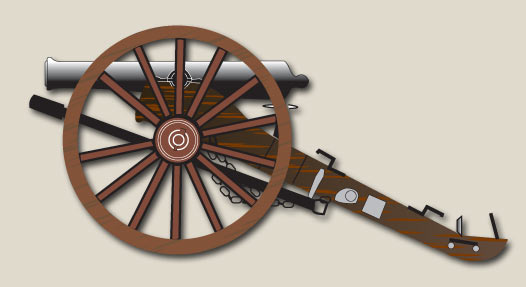Samuel Colt's Competition from Abroad, Robert Adams Revolver
Read More Articles:
The Napoleon Cannon's Versitile Design Caused Wide Use by By Both Union and Confederate Forces

(Originally Published in the Civil War Courier)
Any student of history knows that the American Civil War is often referred to as the first modern war. There were vast improvements in field artillery such as the innovations in rifling and breech loading. Although this new technology resulted in longer range and greater accuracy, it was highly experimental. As a result, the equipment was unpredictable and sometimes dangerous. Therefore, it is no surprise that even with the advent of more modern artillery, the Civil War field gunner's weapon of choice for both the Blue and the Gray was the Napoleon Cannon.
The Napoleon cannon is a generic term for a 12-pounder field artillery piece. It has also been titled Gun-Howitzer, Light 12-pounder and 12-pounder gun, Model 1857. The Napoleon cannon brought smoothbore technology to its greatest height.
The importance of maneuverable field artillery fully came to the American military's attention during the Mexican War. The artillery in General Scott's army became invaluable because it was able to outpace the infantry and keep up with the retreating enemy. One key example was in the pursuit of the Mexican forces fleeing from Chapultepec and heading for Mexico City. Not only were the artillery in this instance able to further force the retreat, but they also managed to hold their ground against a Mexican cavalry attack unaided by infantry or cavalry. The Mexican War was really the first time that American artillery and infantry worked cohesively in defeating an enemy.
The French had learned the importance of a maneuverable field piece to support its infantry during the Napoleonic Wars. They continued to create innovative artillery works throughout the 19th Century. During the 1840s the French military came up with new limbers and carriages, which greatly helped the movement of batteries.
French expertise continued to push smooth bore technology. In 1850 Louis Napoleon initialized a series of tests with the goal of creating a new form of artillery. Napoleon III's intention was to design a single piece of medium weight and 12-pounder caliber cannon. He hoped to be able to substitute this piece of military technology for the 8- and 12-pounder guns along with 24- and 32-pounder howitzers. The need for this substitution resulted from the fact that there were simply too many varieties of caliber cannon. He hoped the device could be used to fire both shot and shell. Napoleon III also felt that field artillery needed to be more light weight. The weapon that resulted from the tests was relatively successful at meeting all of Napoleon's goals.
The biggest problem with organizing batteries in the Mid-Nineteenth Century was the two different types of cannon. The difference between guns and howitzers is primarily that a gun fires on a flat trajectory, while a howitzer fires up into the air so that it can drop its projectile behind protecting walls or cover. A howitzer normally has an adjustable propelling charge so that various trajectory alternatives can be chosen to suit the selected target. The defining characteristic of the howitzer is that it requires a lower charge and sends forth an explosive shell rather than a solid ball. This stems from the howitzers use of a chamber, which a gun does not have. Finally, a gun normally has a longer barrel than a howitzer.
During the 1850s the American military also recognized the need for limiting the wide variety of calibers. This was to create an improved equilibrium between fire power and mobility. A conclusion was reached that a battery should contain either, four 12-pounders and two 24- or 32-pounder howitzers (12-pounder battery); or it should contain four 6-pounders and two 12-pounder howitzers (6-pounder battery). The redesign of batteries extended the field artillery's mission and made both light and heavy field artillery pieces more available. The restructuring of artillery units was primarily done to aid in the bombardment of fortifications and to counter garrison pieces so that the infantry could advance when attacking an entrenched enemy.
The French found the 12-pounder Napoleon to be a great solution for their artillery dilemma and adopted it as their sole field piece. The Russians, Prussians, and Austrians followed the French example.
In 1855-56 Major Alfred Mordecai of the United States Army traveled through Europe on a fact-finding mission to study new improvements in field artillery. Even with the popularity of the Gun-howitzer, and advice from experienced European sources that the War Department should adopt the Napoleon, Mordecai was not sold. He believed that the Napoleon's weight would sacrifice strength and durability.
Most American artillery officers noted that the Napoleon had advantages over pervious 12-pounders. The previous version of a 12-pounder created in 1841 weighed 1,750 pounds while the new Napoleon only weighed about 1,200 pounds. The carriage which transported the barrel weighed approximately 1,130 pounds. This gave the Napoleon a combined weight of about 2,330 pounds.
The light weight of the gun-howitzer made it as maneuverable as a 6-pounder, especially when it was hitched to a limber, a two wheeled wagon that carried ammunition. Both the cannon and limber were pulled by a team of six, and sometimes four horses. To steer the cannon and limber, there were two men riding two of the horses.
Weight and maneuverability were all well and good, but it is important to note that the range of the Napoleon was also excellent. The cannon had the same range as earlier 12-pounders, this being 1,680 yards. Gun howitzers also had an impressive muzzle velocity of 1,485 feet per second. With this range and velocity it was a surprising feat that the Napoleon only required a 2.5 pound propellant charge. Above all, it was reasonably accurate.
The Napoleon was a compromise in trajectory between that of a gun and a howitzer (hence the name Gun-Howitzer). However, at the point of the Civil War, the difference between the trajectory of the two was a subtle one. This was because neither the howitzer nor the gun really had a carriage that was designed to give the barrel a great deal of elevation.
With all of its advantages, the Napoleon seemed to be the ideal field artillery piece, and in 1856 the War Department, finally agreed. Jefferson Davis, Secretary of War announced that the War Department planned to adopt the Napoleon for general field artillery employment.
In 1857 at the Ames Manufacturing Co. in Chicopee, Massachusetts, the first American made Napoleon cannon came into existence. This very gun is currently on display at the Petersburg National Military Park. This early gun is the only true Napoleon style cannon that was ever made in the United States. All of the models that were made after it are considered modified. The first cannon was only 61 inches in length.
The subsequently modified Napoleons were three inches longer. This change unfortunately increased the weight of the gun. It also reduced the preponderance, or excess weight in the section behind the Trunnions. The American Army felt that the reduction in preponderance was a needed improvement and well worth the excess weight.
The first 36 Napoleons created in the United States, including the only authentic Napoleon, had handles. The federal version which is most commonly seen today, does not have handles. All Napoleon cannons have a smooth bore of 4.62 inches and are muzzle loading.
The gun-howitzer was the most popular weapon of both United States' and Confederate Gunners. Therefore, both sides manufactured it. Those interested in identifying the difference between the Union model and Confederate model need only look at the muzzle swell. For the most part, the United States was the primary manufacturer of Napoleon cannons with muzzle swells. The confederate version is a further modification of the original French version, and does not have a rounded muzzle.
However, the Confederacy also created some Napoleon's with a muzzle swell, one of which also had a muzzle band. Towards the end of the war, the Confederacy ran out of copper. This left them in a dilemma because the Napoleon was originally a bronze cannon. The Confederate powers were forced to cast the cannon entirely in iron. Iron is not the best material for arms because of its rigidity. To counteract this, the diameter of the cannon was increased. Unfortunately this raised the weight of the Napoleon.
Another advantage of the Napoleon Cannon was the new standard of durability that the weapon set. It was not uncommon for a six-gun battery of bronze Union made Napoleons to fire more than 1,200 rounds of ordinance in a single engagement. This long hard use did not create lots of distortion or wear on the tube. Compare that to the Parrott style Swamp Angel, which only fired 34 rounds before it was spent. This particular instance was of course partially due to faulty ammunition.
The gun-howitzer was also a versatile piece of artillery that could project a wide range of ammunition. Solid shot was used for long-range shelling or for its ability to break through cover. If the enemy was hidden in the woods, gunners used solid shot to destroy the trees.
If the enemy was in an open field spherical case was usually the ammunition of choice. This round was hollow sphere filled with musket balls. Spherical case was designed so that the friction of the shell traveling through the tube when fired would ignite a fuse in the shell. The shell would in turn explode over the heads of the enemy infantry pouring musket balls and broken shell fragments on them.
Possibly the most deadly form of antipersonnel ammunition in the Civil War through, was canister. Canisters were basically tin cans filled with 27 1½ inch round balls stacked on top of each other. When fired they produced the same effect as a shotgun blast. If the enemy was at very close range, and threatened to overrun the battery, cannoneers would load double canister. Double canister is two canisters rammed together down the barrel on top of a strong charge of black powder. This ammunition had the capability of wiping out entire ranks of men. With Canister, Shell and Spherical case, the Napoleon cannon was an extremely versatile weapon.
The model 1857 was also a very forgiving weapon as far as safety was concerned. In one particular incident at Antietam, an infantryman, with no previous experience helped to man a gun in Campbell's battery. This was to aide in the repulse of Hood's attack. The untrained infantryman loaded double canister and discharged unaware that he was supposed to remove the powder charge from the second round before loading! The overloaded gun viciously jumped into the air with each round. Surprisingly though, it was still usable after the fiasco.
Weight, maneuverability range, versatility, durability, and safety were all the characteristics that brought the Napoleon cannon to its wide use during the Wear Between the States. It is not surprising then that the smooth bore muzzle loading artillery piece managed to rival the modern breech loading rifled artillery during the first modern war.
